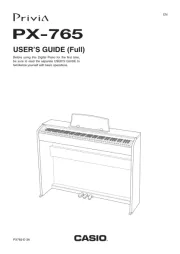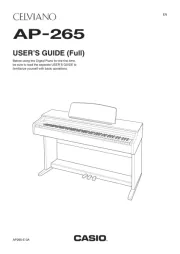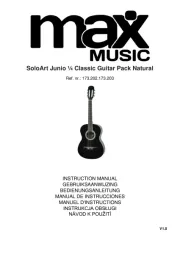Pyle PCJD16 Bedienungsanleitung
Pyle
musikinstrument
PCJD16
Lies die bedienungsanleitung für Pyle PCJD16 (2 Seiten) kostenlos online; sie gehört zur Kategorie musikinstrument. Dieses Handbuch wurde von 42 Personen als hilfreich bewertet und erhielt im Schnitt 4.4 Sterne aus 21.5 Bewertungen. Hast du eine Frage zu Pyle PCJD16 oder möchtest du andere Nutzer dieses Produkts befragen? Stelle eine Frage
Seite 1/2

PCJD25 - PCJD16 cajon is a box, usually constructed from hardwood, that
you sit on whilst playing. When you hit any face of the cajon, the wood will
resonate to produce a tone. Harder woods like birch & beech tend to produce
stronger more dened bass tones & more cutting high tones. Each wood has
its own sound characteristics. The top surface forms a seat.
The best approach to playing your cajon is to spend time playing the various
surfaces using dierent intensities (hardness) of stroke & playing in dierent
places (eg. top, middle, bottom, side). Get to know your cajon & understand
how you create dierent tones & sounds.
Stroke
• Bass : Same as drum’s kick.
• Tone : Same as drum’s rich snare.
• Tip : Works just like hi-hat or percussion.
For background percussive sounds or
ghost notes.
• Slap : Same as drum’s agile snare.
More stronger sound than Tone.
• Finger : Finger stroke sounds.
Very useful for ghost notes.
• Noise : Swirl sounds with brushed
or hands.
Slap
Tone
Tip
Bass

Other Wooden Cajon Percussion Box and Accessories from :PyleUSA
PCJD15
Stringed Jam Cajon
Wooden Cajon Percussion Box
PCJDBG15
Cajon Travel/Storage Bag
(For Pyle Models: PCJD15,
PCJD16 and PCJD25)
PCJD18
Stringed Jam Cajon
Wooden Cajon Percussion Box
PCJDBG18
Cajon Travel/Storage Bag
(For Pyle Model: PCJD18)
Produktspezifikationen
| Marke: | Pyle |
| Kategorie: | musikinstrument |
| Modell: | PCJD16 |
Brauchst du Hilfe?
Wenn Sie Hilfe mit Pyle PCJD16 benötigen, stellen Sie unten eine Frage und andere Benutzer werden Ihnen antworten
Bedienungsanleitung musikinstrument Pyle

1 September 2024

24 August 2024

24 August 2024

24 August 2024

24 August 2024

22 August 2024

12 August 2024

4 August 2024

3 August 2024

1 August 2024
Bedienungsanleitung musikinstrument
- Artesia
- Otamatone
- Gretsch Guitars
- Chord
- Jupiter
- Gravity
- La Crosse Technology
- IK Multimedia
- Woodley
- Eurolite
- Efnote
- Palmer
- DW Drums
- Elektron
- Max
Neueste Bedienungsanleitung für -Kategorien-

16 Juni 2025

15 Juni 2025

10 Juni 2025

4 Dezember 2024

24 September 2024

24 September 2024

24 September 2024

19 September 2024

10 September 2024

10 September 2024